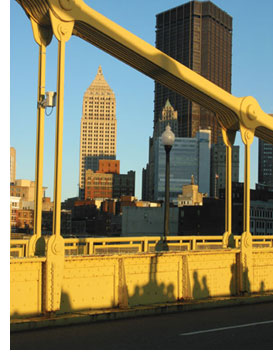Back
 What
I did on my summer vacation: built a city. What
I did on my summer vacation: built a city.
It’s not
as outlandish as it sounds, thanks to a new collaboration
between Carnegie Museum of Art and Carnegie
Mellon University School of Architecture, with support
from Pittsburgh History & Landmarks Foundation and
the Riverlife Task Force.
This summer, for two weeks at
a time, groups of kids aged 8-10, 11-13, and high school-aged
will join peers with
similar interests to get a one-of-a-kind look at city planning
and design. Called Urban Revolution, it’s one of
the Museum of Art’s Architecture Camps and Workshops,
a new addition to the museum’s Summer Arts program.
“
When Marilyn [Russell] called to say ‘let’s
partner,’ I was very excited,” recalls Kelly
Docter, K-12 Outreach Coordinator for Carnegie Mellon’s
School of Architecture. Russell, chair and curator of education
for Carnegie Museum of Art, knew she would be incorporating
architecture into the museum’s summer-camp mix for
2005; she just wasn’t exactly sure what form it would
take.
“
I realized that both organizations were trying to do the
same thing—give kids rich experiences exploring architecture
from a number of different perspectives,” Russell
says. “The
Museum of Art has an incredible collection that includes
paintings, drawings, architectural models, and the Hall
of Architecture; and Carnegie Mellon
has professional facilities and tremendous expertise in
the teaching of
architecture. Why not join forces and make those experiences
for kids even better? That’s the beauty of this kind
of collaboration; it benefits everyone.”
All architecture camps for
11-13 year-olds and high school kids will take place on
the Carnegie Mellon campus, where
class space is more plentiful, and instructors from the
University’s School of Architecture will lead the
camps. Participants will also spend time exploring images
of cities in Carnegie Museum of Art’s collection
of paintings and in the Heinz Architectural Center, where
Russell and Docter are working with Curator Tracy Myers
to organize an installation of complementary drawings and
models from the Center’s collections.
Urban Revolution goes a step further by taking kids out of the university
and museum setting and challenging them to really think
big. As Docter points out, Urban Revolutionists will
have one of the best cities in the country, if not the
world, to explore as a case study: Pittsburgh.
“
This is a wonderful city to get kids to appreciate the
old while also thinking about the new,” Docter says. “We
have fabulous buildings in Pittsburgh.” And, thanks
to the Pittsburgh History & Landmarks Foundation, kids
in the two-week Urban Revolution program will tour some
of Pittsburgh’s best
vintage architectural treasures. The Riverlife Task Force
is also pitching in to give the kids a look at the riverfronts
and an assessment of current and future development along
Pittsburgh’s waterways.
Finally, after seeing for
themselves all that city planners, architects, and builders
have to contend with when creating,
maintaining, and modernizing cities, Urban Revolutionists
will return to the museum and the Carnegie Mellon studio
to design a city of their own. Docter says they’ll
first have to consider three important elements of any
city plan: housing, open space, and commercial/industrial
space. They’ll also be asked to think about all that
a city should have in it.
“
It’s interesting what comes to mind when you ask
kids to think about the important elements of a city,” Docter
notes. “Boys often think first about things like
sports stadiums—but when you ask them what would
happen if their sports stadium catches fire, they remember, ‘oh
yeah, we need a fire station!’ It’s a great
exercise; the kids soon realize that things like a jailhouse,
a fire station, and theaters are integral to a city.”
 The
most important thing kids will take away from the two-week
Urban Revolution, Docter says, is the iterative nature
of the whole process: the constant discussion; the thinking
and rethinking. The
most important thing kids will take away from the two-week
Urban Revolution, Docter says, is the iterative nature
of the whole process: the constant discussion; the thinking
and rethinking.
“
This is an incredibly important part of design,” she
notes—and, as these kids will learn, it’s the
part of planning the buildings and cities of tomorrow that
you can’t learn in a textbook.
“This
is a wonderful city to get kids to appreciate
the old while also thinking
about the new. We have fabulous
buildings in Pittsburgh.”
– Kelly Docter, Carnegie
Mellon School of Architecture
To learn
more about Carnegie Museum of Art’s Summer
Arts and Architecture Camps and Workshops, review the Calendar
insert in this magazine, visit www.cmoa.org, or call 412.622.3288.
Registration is open throughout the summer months, and
scholarships are available.
Back
| Top |